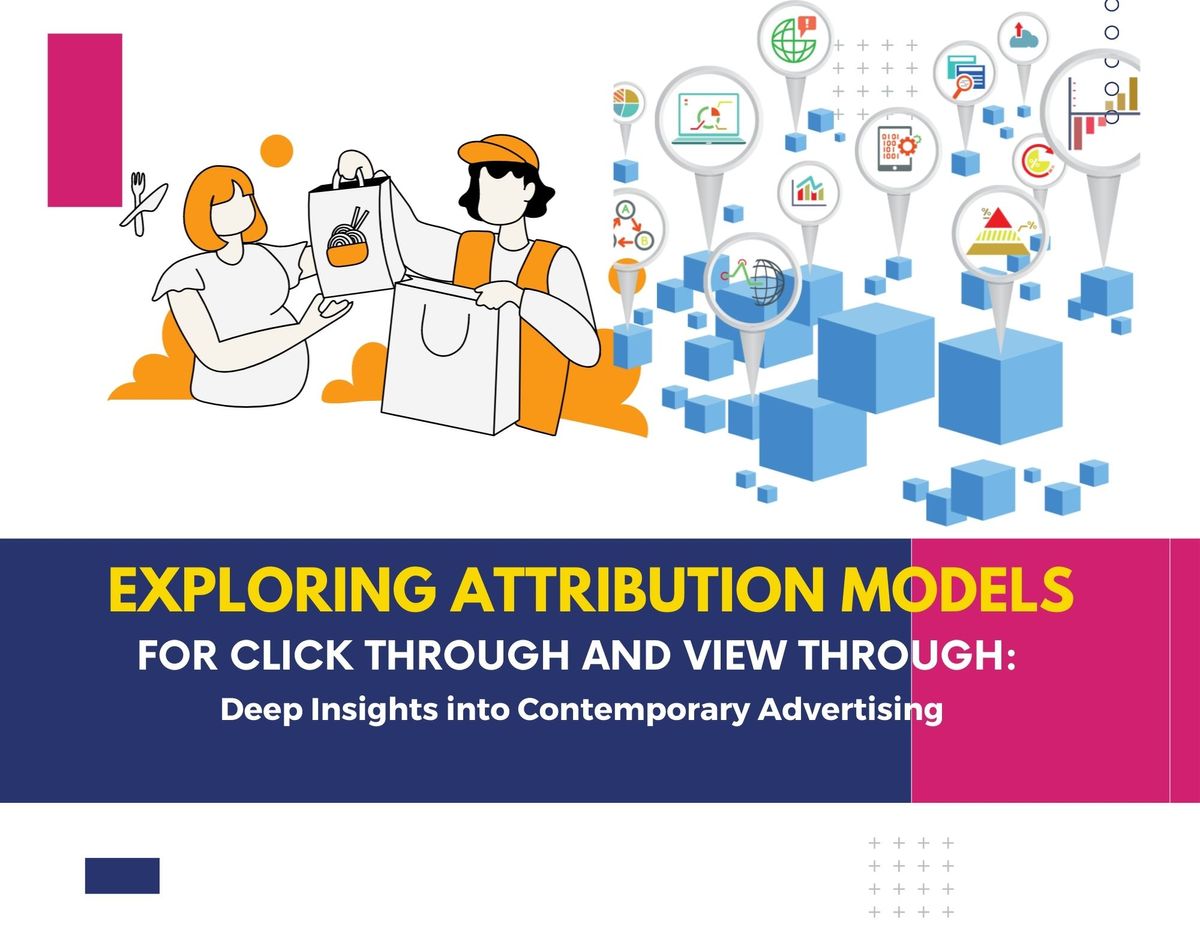Exploring Attribution Models for Click-Through and View-Through: Deep Insights into Contemporary Advertising.

The adage "Half the money I spend on advertising is wasted; the trouble is, I don't know which half," attributed to 19th-century merchant John Wanamaker, encapsulates the central conundrum of advertising. Despite the digital revolution, uncertainty persists; but through advances in data analysis and the adoption of sophisticated attribution models, this ambiguity is gradually eroding.
Attribution Models: An Overview
Attribution models are data-driven frameworks used to identify the touchpoints or actions contributing to a conversion or sale. There are various models available, but the two that are gaining significant traction in the contemporary digital advertising landscape are Click-Through Attribution (CTA) and View-Through Attribution (VTA). Both these models have their unique strengths and weaknesses that necessitate a nuanced understanding.

Click-Through Attribution
CTA gives credit to the last clicked ad before a conversion. It emphasizes direct interaction between an ad and a user, thereby valuing tangible engagement over mere exposure. The clear-cut nature of this model is both its strength and its weakness.
On the upside, CTA is unambiguous and straightforward to track and measure, making it an attractive option for many advertisers. The attribution is unequivocal, and the subsequent insights can directly influence future campaigns.
However, this model overlooks the cumulative impact of multiple touchpoints. In the real world, customers often engage with multiple ads from various channels before deciding to convert. By crediting the last clicked ad, the CTA model oversimplifies the conversion path and can potentially lead to misallocated marketing resources.
View-Through Attribution
VTA gives credit to the last viewed ad before conversion, even if the user didn't click on it. This model recognizes that not all conversions are preceded by a click and that mere exposure to an ad can influence purchasing decisions.
VTA offers a broader understanding of an ad's influence, recognizing that ads can contribute to brand awareness and slowly build intent over time, leading to a conversion. This more holistic perspective helps advertisers gain insights into the subliminal influence of their ads.
Despite its advantages, VTA isn't without its challenges. Determining an accurate conversion window is tricky. Moreover, the causal relationship between viewing an ad and converting is less direct, leading to potential over-attribution. Privacy concerns can also complicate VTA tracking as it generally requires third-party cookies, a technology under increasing scrutiny.

What is the intended purpose of an attribution model?
The purpose of an attribution model is to help businesses identify the series of events or touchpoints that contribute to a desired outcome, typically a sale or a conversion. In the realm of digital marketing, these touchpoints can include a variety of interactions such as clicks on a PPC ad, views of a display ad, direct website visits, email campaigns, social media posts, and more.
Here are the key objectives of an attribution model:
1. Understanding the Customer Journey: Attribution models help advertisers understand the complete customer journey. They reveal the sequence of interactions or touchpoints that a customer engages with before eventually making a purchase or completing a desired action.
2. Allocating Credit: Attribution models determine how much credit each touchpoint deserves for a conversion. Depending on the model used, this credit can be distributed equally across all touchpoints (as in a linear model), or it can be weighted more heavily towards the first or last interaction (as in the first-touch or last-touch models), among other possibilities.
3. Optimizing Marketing Efforts: By understanding which touchpoints are contributing the most to conversions, businesses can optimize their marketing strategies. They can invest more heavily in channels and campaigns that are proven to drive results and reduce or eliminate spending on less effective activities.
4. Informing Future Strategies: Insights derived from attribution models can guide future marketing strategies. Knowing which channels and campaigns are most effective can help businesses plan their future marketing efforts more effectively, enhancing their overall return on investment (ROI).
5. Facilitating Personalization: Attribution models can also enable more personalized marketing. By understanding a customer's unique journey, businesses can tailor their marketing messages to better fit the customer's needs and preferences, increasing the likelihood of conversion.
Remember, the purpose of an attribution model is to give businesses a clearer understanding of what's driving their conversions, allowing them to optimize their marketing strategies, enhance their ROI, and deliver more personalized and effective advertising.

What does a retargeting campaign signify within the context of a View-Through Attribution model?
A retargeting campaign is a form of online advertising that allows businesses to re-engage with users who have previously interacted with their brand but did not convert. This could include visitors who have browsed a website, viewed specific products, or added items to their shopping cart but left before making a purchase.
When it comes to the View-Through Attribution (VTA) model, a retargeting campaign is particularly relevant. Here's how it works:
1. Tracking: Using cookies or pixels, the advertiser tracks the actions of users on their website.
2. Segmentation: The users are then segmented based on their behaviour. For instance, those who viewed a specific product or added an item to the cart but didn't make a purchase are identified.
3. Retargeting: Advertisements relevant to their behaviour are then served to these users as they browse other parts of the internet. These ads are intended to remind them of what they left behind and encourage them to return and complete their purchase.
4. Attribution: If a user sees the retargeting ad and later makes a purchase – even if they didn't click on the retargeted ad – the VTA model gives credit to the retargeting campaign for influencing that conversion.
Retargeting within the context of the VTA model allows advertisers to understand and measure the influence of ad impressions that might not have resulted in immediate clicks, but still played a role in guiding consumers toward conversion.
It provides a valuable way to evaluate the impact of advertising on generating brand awareness and building consumer interest, which is often prerequisites to the ultimate conversion.
Relationship Between Attribution Window of View-Through Attribution and Click-Through Attribution
Attribution windows refer to the period during which an interaction (either a click or a view) can be credited for a conversion in the context of attribution models. Both Click-Through Attribution (CTA) and View-Through Attribution (VTA) have their distinct attribution windows.
Attribution Window for Click-Through Attribution (CTA)
In CTA, the attribution window is the period between when a user clicks on an ad and when the user performs a desired action, such as making a purchase. If a user clicks on an ad and converts within the set window, the conversion is attributed to that click.
For example, if a click-through attribution window is set for 30 days, and a user clicks an ad and purchases within those 30 days, that conversion is credited to the clicked ad. The length of this window can be adjusted based on the typical buying cycle of the product or service being marketed.
Attribution Window for View-Through Attribution (VTA)
In VTA, the attribution window is the period between when a user views an ad and when the user converts. The key difference here is that the user doesn't have to click on the ad; the user merely has to view the ad, and if they convert within the set attribution window, the conversion is credited to the viewed ad.
For example, if a view-through attribution window is set for 7 days, and a user sees an ad and then purchases within those 7 days (without clicking the ad), the conversion is attributed to the viewed ad.
The VTA window is generally shorter than the CTA window, often ranging from 24 hours to 7 days. This shorter window is used because the influence of a viewed (but not clicked) ad is thought to diminish more rapidly than that of a clicked ad.
However, just as with CTA, the ideal length of the VTA window can depend on various factors, such as the nature of the product or service, the marketing strategy, and the typical customer buying cycle.
The Merger of CTA and VTA: An Integrated Approach
A growing trend in the industry is to leverage both CTA and VTA models to gain a more comprehensive understanding of the customer journey. By combining the insights from both models, advertisers can better appreciate the influence of different types of ads and interactions on the conversion process.
Using CTA, advertisers can track the immediate response to an ad and measure the ad's ability to drive a direct conversion. Simultaneously, using VTA, advertisers can gauge the longer-term impact of an ad in terms of creating brand awareness and building intent.
Mitigating Overlap Between CTA and VTA
One of the challenges in using both CTA and VTA models simultaneously is the potential for overlap. A conversion could be attributed to both a clicked ad and a viewed ad, leading to confusion and over-attribution. However, advertisers can mitigate this risk by adopting a preference system.
For example, an advertiser could decide to credit a conversion to a clicked ad if both a clicked and viewed ad is present in the conversion path. This preference system helps resolve the potential overlap issue and ensures that each conversion is only counted once.
Developments in Attribution Modeling
As the advertising industry becomes increasingly sophisticated, attribution models continue to evolve. We are seeing an increased emphasis on machine learning and artificial intelligence techniques, which promise to deliver more accurate, nuanced, and adaptable attribution models.
Moreover, cross-device attribution is becoming more prevalent in the face of the growing number of devices and channels that consumers use. This advancement requires a holistic approach, taking into account all interactions a consumer has with a brand, regardless of the device or platform.
Navigating the Future of Attribution
While both CTA and VTA offer valuable insights, the future of attribution modelling seems to be heading towards a more integrated and sophisticated approach. As customers interact with brands through an ever-increasing number of channels and touchpoints, advertisers will need to evolve their attribution models to keep up with this complexity.
In conclusion, understanding the intricacies of attribution models is crucial for modern advertisers. Recognizing the merits and limitations of each model, and embracing the possibilities offered by technological advancements, will allow businesses to navigate the complex digital landscape more effectively and succeed in their advertising efforts.





